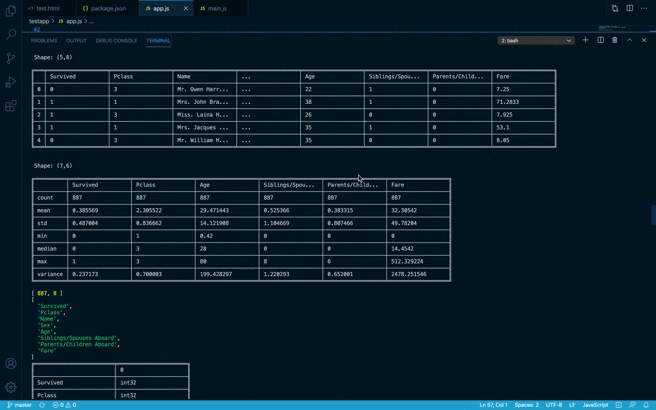Danfo
high performance, intuitive, and easy to use data structures for manipulati...
README

Danfojs: powerful javascript data analysis toolkit


What is it?
Danfo.js is a javascript package that provides fast, flexible, and expressive data
structures designed to make working with "relational" or "labeled" data both
easy and intuitive. It is heavily inspired by Pandas library, and provides a similar API. This means that users familiar with Pandas, can easily pick up danfo.js.
Main Features
- Danfo.js is fast and supports Tensorflow.js tensors out of the box. This means you can convert Danfo data structure to Tensors.
- Easy handling of missing-data (represented as
NaN) in floating point as well as non-floating point data
- Size mutability: columns can be inserted/deleted from DataFrame
- Automatic and explicit alignment: objects can
be explicitly aligned to a set of labels, or the user can simply
ignore the labels and let Series, DataFrame, etc. automatically
align the data for you in computations
- Powerful, flexible groupby functionality to perform
split-apply-combine operations on data sets, for both aggregating
and transforming data
- Make it easy to convert Arrays, JSONs, List or Objects, Tensors and
differently-indexed data structures
into DataFrame objects
large data sets
sets
- Robust IO tools for loading data from flat-files
(CSV, Json, Excel).
- Powerful, flexible and intutive API for plotting DataFrames and Series interactively.
- Timeseries-specific functionality: date range
generation and date and time properties.
- Robust data preprocessing functions like OneHotEncoders, LabelEncoders, and scalers like StandardScaler and MinMaxScaler are supported on DataFrame and Series
Installation
There are three ways to install and use Danfo.js in your application
For Nodejs applications, you can install the [__danfojs-node__]() version via package managers like yarn and/or npm:
- ``` sh
- npm install danfojs-node
- or
- yarn add danfojs-node
- ```
For client-side applications built with frameworks like React, Vue, Next.js, etc, you can install the [__danfojs__]() version:
- ``` sh
- npm install danfojs
- or
- yarn add danfojs
- ```
For use directly in HTML files, you can add the latest script tag from JsDelivr to your HTML file:
- ``` html
- <script src="https://cdn.jsdelivr.net/npm/danfojs@1.1.2/lib/bundle.js"></script>
- ```
See all available versions here
Quick Examples
Example Usage in the Browser
- ``` html
- <!DOCTYPE html>
- <html lang="en">
- <head>
- <meta charset="UTF-8" />
- <meta name="viewport" content="width=device-width, initial-scale=1.0" />
- <script src="https://cdn.jsdelivr.net/npm/danfojs@1.1.2/lib/bundle.js"></script>
- <title>Document</title>
- </head>
- <body>
- <div id="div1"></div>
- <div id="div2"></div>
- <div id="div3"></div>
- <script>
- dfd.readCSV("https://raw.githubusercontent.com/plotly/datasets/master/finance-charts-apple.csv")
- .then(df => {
- df['AAPL.Open'].plot("div1").box() //makes a box plot
- df.plot("div2").table() //display csv as table
- new_df = df.setIndex({ column: "Date", drop: true }); //resets the index to Date column
- new_df.head().print() //
- new_df.plot("div3").line({
- config: {
- columns: ["AAPL.Open", "AAPL.High"]
- }
- }) //makes a timeseries plot
- }).catch(err => {
- console.log(err);
- })
- </script>
- </body>
- </html>
- ```
Output in Browser:

Example usage in Nodejs
- ``` js
- const dfd = require("danfojs-node");
- const file_url =
- "https://web.stanford.edu/class/archive/cs/cs109/cs109.1166/stuff/titanic.csv";
- dfd
- .readCSV(file_url)
- .then((df) => {
- //prints the first five columns
- df.head().print();
- // Calculate descriptive statistics for all numerical columns
- df.describe().print();
- //prints the shape of the data
- console.log(df.shape);
- //prints all column names
- console.log(df.columns);
- // //prints the inferred dtypes of each column
- df.ctypes.print();
- //selecting a column by subsetting
- df["Name"].print();
- //drop columns by names
- let cols_2_remove = ["Age", "Pclass"];
- let df_drop = df.drop({ columns: cols_2_remove, axis: 1 });
- df_drop.print();
- //select columns by dtypes
- let str_cols = df_drop.selectDtypes(["string"]);
- let num_cols = df_drop.selectDtypes(["int32", "float32"]);
- str_cols.print();
- num_cols.print();
- //add new column to Dataframe
- let new_vals = df["Fare"].round(1);
- df_drop.addColumn("fare_round", new_vals, { inplace: true });
- df_drop.print();
- df_drop["fare_round"].round(2).print(5);
- //prints the number of occurence each value in the column
- df_drop["Survived"].valueCounts().print();
- //print the last ten elementa of a DataFrame
- df_drop.tail(10).print();
- //prints the number of missing values in a DataFrame
- df_drop.isNa().sum().print();
- })
- .catch((err) => {
- console.log(err);
- });
- ```
Output in Node Console:

Notebook support
VsCode nodejs notebook extension now supports Danfo.js. See guide here
ObservableHQ Notebooks. See example notebook here
Documentation
The official documentation can be found here
Danfo.js Official Book
We published a book titled "Building Data Driven Applications with Danfo.js". Read more about it here
Discussion and Development
Development discussions take place here.
Contributing to Danfo
All contributions, bug reports, bug fixes, documentation improvements, enhancements, and ideas are welcome. A detailed overview on how to contribute can be found in the contributing guide.
 探客时代
探客时代

